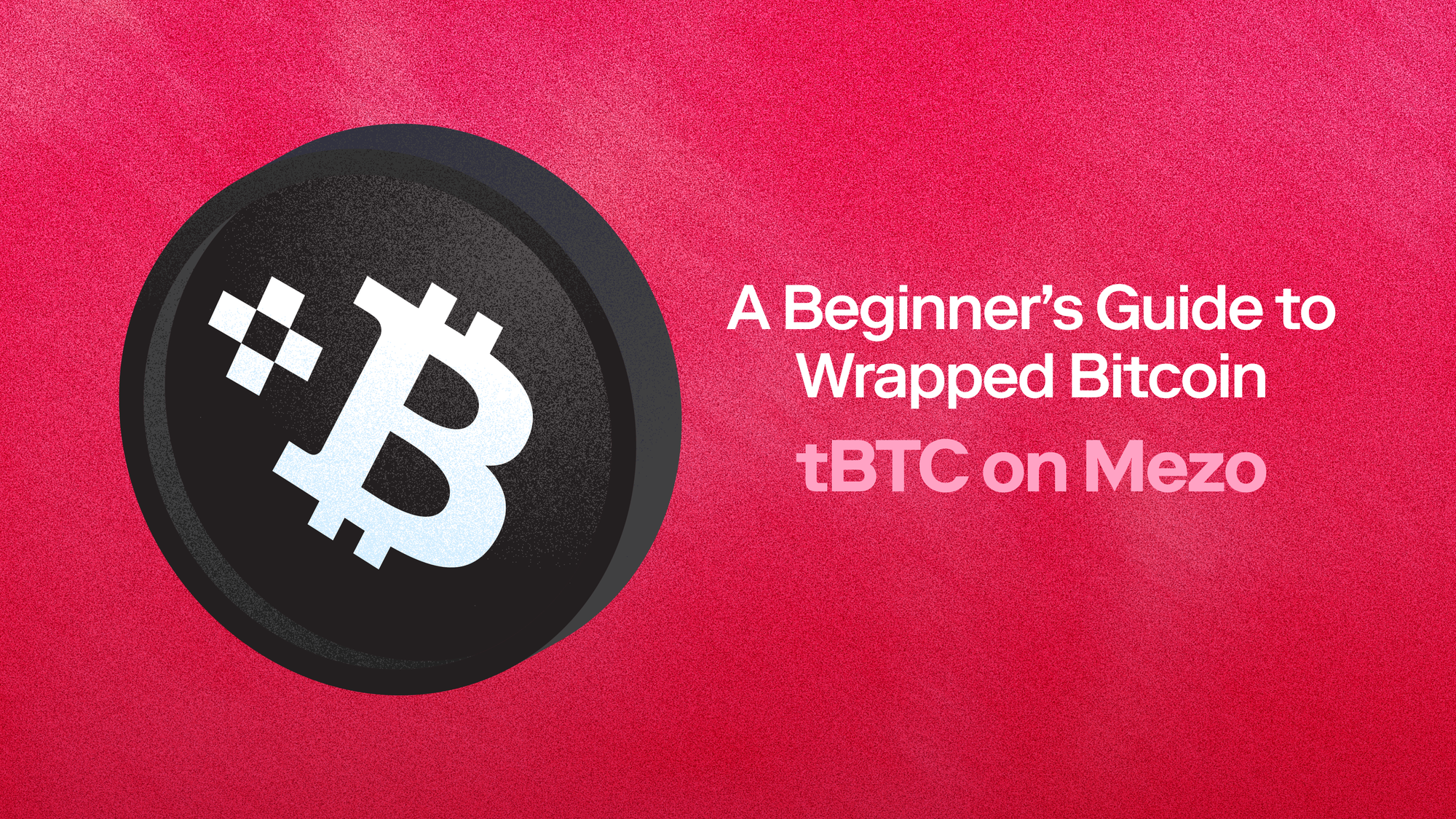How Mezo Wraps BTC: A Guide to tBTC
Learn how to wrap Bitcoin safely on Mezo with tBTC. This step-by-step guide covers what wrapping changes, tBTC vs WBTC custody, minting, routing, monitoring, and redeeming back to BTC, plus fees, timings, audits, and address checks. Start now on Mezo. Bank on yourself.

Being your own bank starts with controlling your Bitcoin, but traditional banking functions have historically required handing custody to intermediaries. Wrapping Bitcoin means locking your native BTC and minting an onchain representation (NFT) that works across EVM networks without surrendering that control.
On Mezo, that representation is tBTC—a trust-minimized Bitcoin bridge that lets you use your Bitcoin as collateral to mint MUSD, provide liquidity in Mezo Pools, and pay transaction fees, all while maintaining the sovereignty that makes Bitcoin valuable in the first place. Unlike custodial alternatives, where a third party holds your keys, tBTC uses threshold cryptography to eliminate single points of control, preserving the principle that you remain your own bank even when your Bitcoin enters programmable finance.
Why Mezo Uses tBTC Instead of WBTC
The wrapped Bitcoin market has historically been dominated by WBTC, which uses BitGo as a custodian and requires merchants to handle minting and burning through a KYC process. Users don't interact directly with the custody layer; instead, they go through approved merchants who manage the BTC deposits and WBTC issuance. While this model has served the market for years, it introduces a central point of control.
tBTC takes a different approach. The Threshold Network operates the bridge using threshold ECDSA, where randomly selected, staked operators collectively control Bitcoin wallets without any single party holding full custody. When you deposit Bitcoin, the protocol generates an SPV proof of your transaction and uses Optimistic Minting to deliver tBTC in roughly three to four hours. This system uses a 51-of-100 threshold signature scheme with rotating signer sets, and governance happens through the Threshold DAO rather than a single custodian.
For Mezo users, this distinction matters because tBTC enables you to interact with the platform without introducing custodial risk into your Bitcoin collateral. When you mint MUSD against your Bitcoin holdings, you're building on a trust-minimized foundation that extends from the BTC you deposit all the way through to the stablecoin you borrow.
Depositing Bitcoin to Mezo
Wrapping Bitcoin for use on Mezo happens in two main ways. The most straightforward approach is to deposit directly through the Mezo app. You'll need a Bitcoin wallet like UniSat, OKX, or Xverse and MetaMask for signing transactions on the Mezo side. The minimum deposit is 0.01 BTC—amounts below this threshold can fail, so avoid testing with smaller values.
When you open the Mezo deposit interface and select "Deposit," and select the asset you’d like to deposit. Copy this address, then send your selected address from your wallet using a competitive miner fee to ensure timely confirmation. Behind the scenes, the bridge produces an SPV proof of your deposit, mints tBTC, and credits your Mezo address. The process typically takes three to four hours after your Bitcoin transaction confirms, though timing varies with Bitcoin mempool conditions.
Once your funds arrive on Mezo, you can immediately use them to mint MUSD by posting your BTC as collateral, provide liquidity in Mezo Pools, or simply hold them while earning mats rewards. Because Mezo uses BTC for gas payments through tBTC under the hood, you don't need to acquire a separate gas token before interacting with the platform.
Understanding the Fees and Timing
Minting tBTC carries no protocol fee—you only pay Bitcoin miner fees on your deposit. Threshold's redemption treasury charges 0.2% when you burn tBTC to receive native Bitcoin, a parameter set by DAO governance. When bridging out of Mezo to Ethereum, you'll pay a 0.25% Mezo fee plus a gas fee in BTC, with Mezo covering the final Ethereum gas costs. Withdrawing to native Bitcoin includes that same 0.25% Mezo withdrawal fee, the 0.2% tBTC redemption fee, and a small redemption transaction fee that varies with Bitcoin mempool conditions but caps at 0.001 BTC.
The minimum for any bridge-out operation is 0.01 BTC or BTC-denominated tokens. These minimums exist to ensure transactions remain economically viable against the fee structure. Always review the fee line items displayed in the Mezo interface before confirming transactions—the UI shows exactly what you'll pay, including variable components that depend on network conditions.
Typical timing for the full deposit flow runs three to four hours from Bitcoin confirmation to tBTC arrival, thanks to Optimistic Minting's accelerated process. Redemptions back to native Bitcoin take three to five hours in the standard flow. These ranges assume normal Bitcoin mempool conditions and standard bridge sweep cadences. Setting an inadequate Bitcoin miner fee is the most common cause of delayed confirmations, so always check current fee rates before sending transactions.
Bridging Back to Bitcoin
When you're ready to close a Mezo position, rebalance off-chain, or move Bitcoin to cold storage, the withdrawal process reverses the deposit flow. In the Mezo app, select "Withdraw," choose Bitcoin as your destination, and paste a compatible Bitcoin address. Before submitting, visually confirm the first six and last six characters of the address—copy-paste errors have caused losses, and bridge-outs cannot be canceled.
The status will progress through Created, Attesting, Ready to Withdraw, and finally Withdrawn. Keep your Mezo transaction hash and monitor the process across explorers. After reaching "Withdrawn" status, confirm the incoming Bitcoin transaction appears in your wallet and verify the corresponding events on both the Mezo Explorer and, if relevant, Ethereum for the tBTC burn.
Why This Matters for MUSD Users
On Mezo, your Bitcoin becomes more. tBTC’s underlying infrastructure allows you to use your BTC as collateral to borrow MUSD—a Bitcoin-backed stablecoin—at a low 1% fixed rate. This process is designed to give you access to free-banking without giving up control of your assets.
Here’s what that means for you:
- Uncompromised Security: Mezo uses tBTC, a trust-minimized bridge, not a custodial one. This ensures your Bitcoin collateral remains verifiably backed and secure, maintaining the principle of self-custody from start to finish. The stability of the 1% borrow rate depends on this transparent and robust foundation.
- A Self-Contained Bitcoin Economy: Your Bitcoin acts as collateral for borrowing MUSD and as the token used to pay for transaction fees on the platform. You can deposit, borrow, and transact entirely with Bitcoin, eliminating the need to manage other tokens.
- Free Banking: This system allows you to be your own bank. Unlike traditional finance, where you trust a bank's solvency, here you retain control.
- You control the keys to your collateral.
- You can verify every transaction on a public explorer.
- You interact with transparent smart contracts, not opaque ledgers.
- You can exit back to native Bitcoin whenever you choose.
By combining the security of self-custody with the financial tools of borrowing and earning, Mezo lets you bank on yourself.
Ready to get started? Deposit Bitcoin in the Mezo app to explore yield opportunities or borrow MUSD against your BTC at a 1% fixed rate.
Your Bitcoin. Your Bank. Your Terms.
